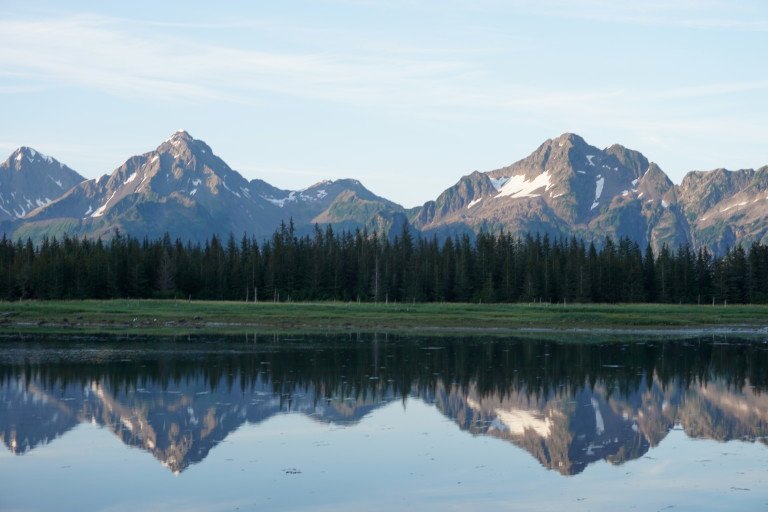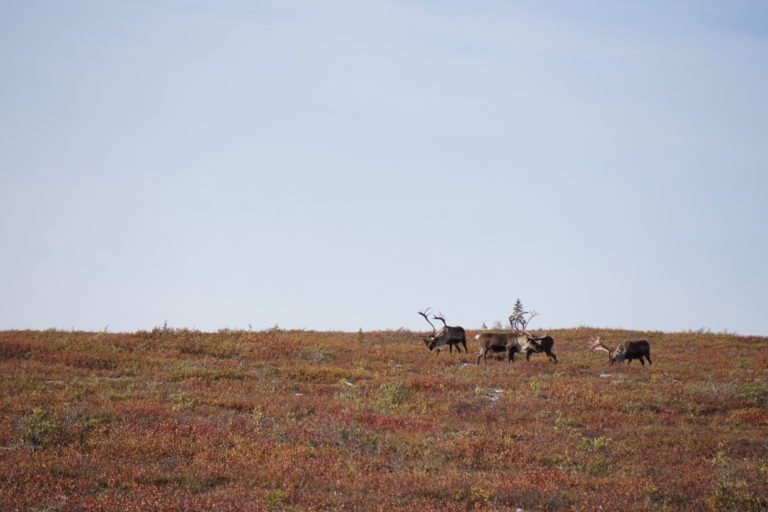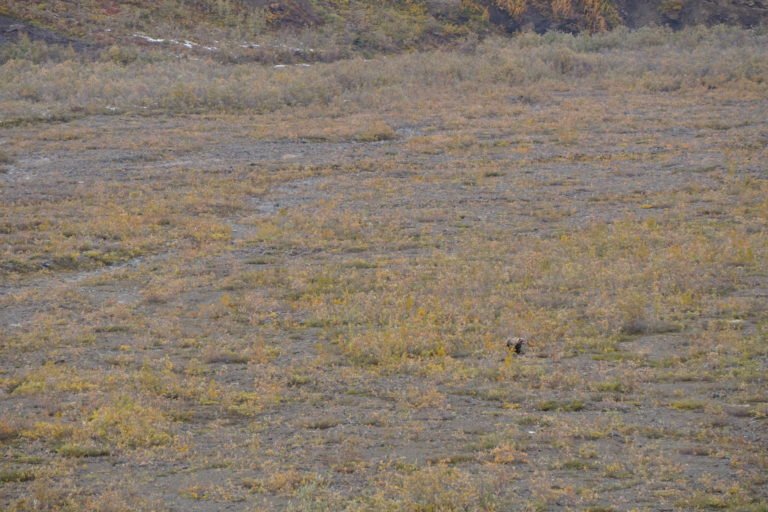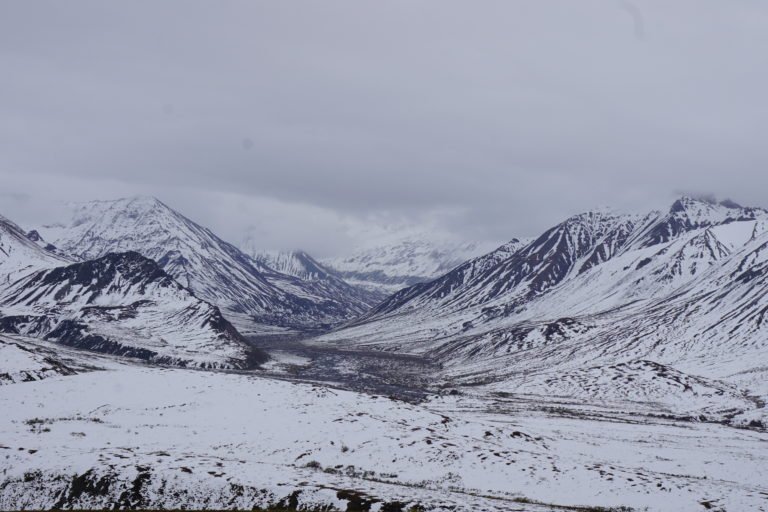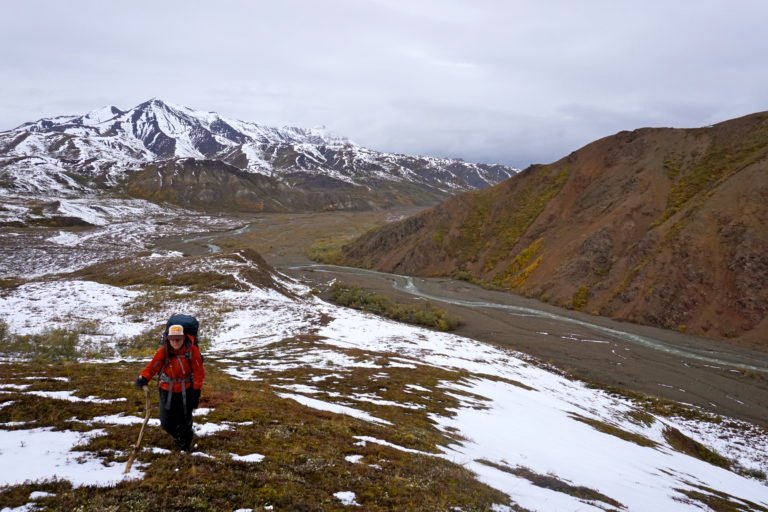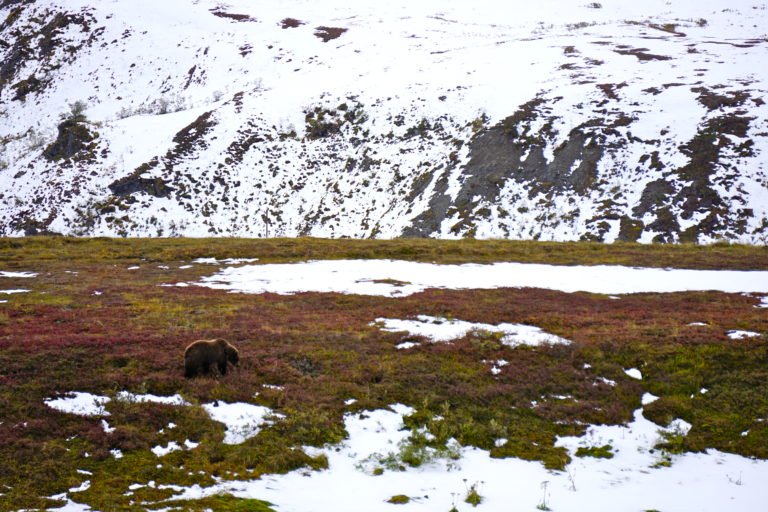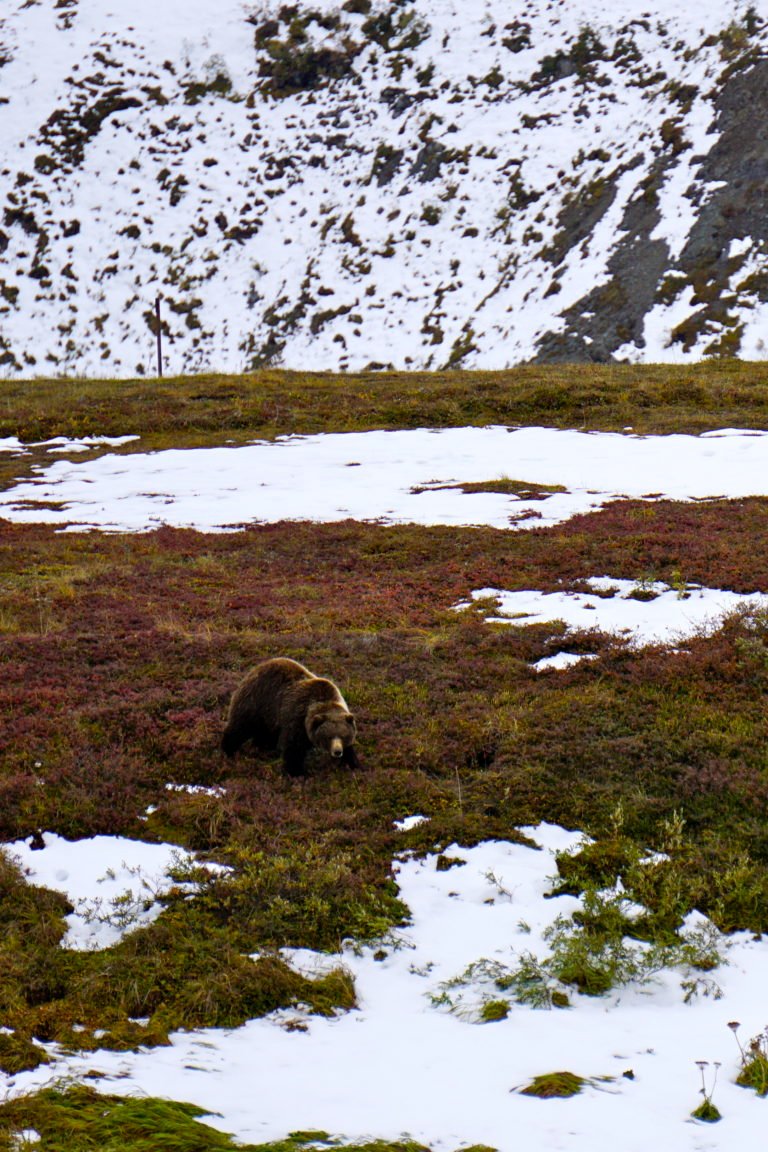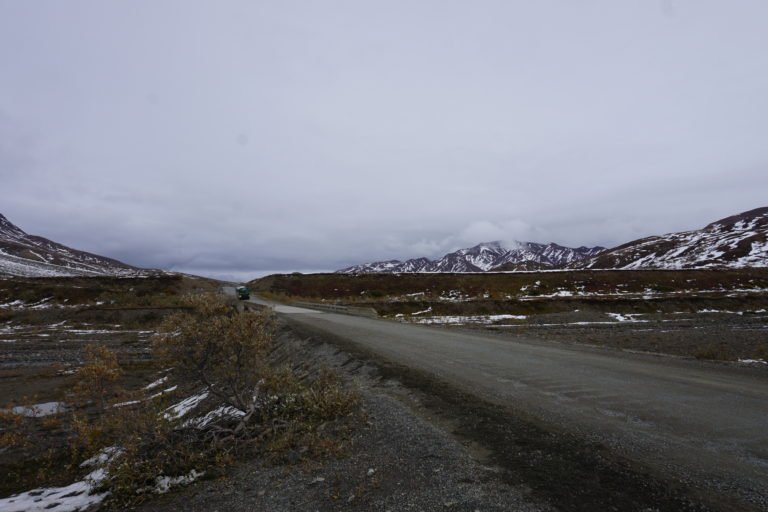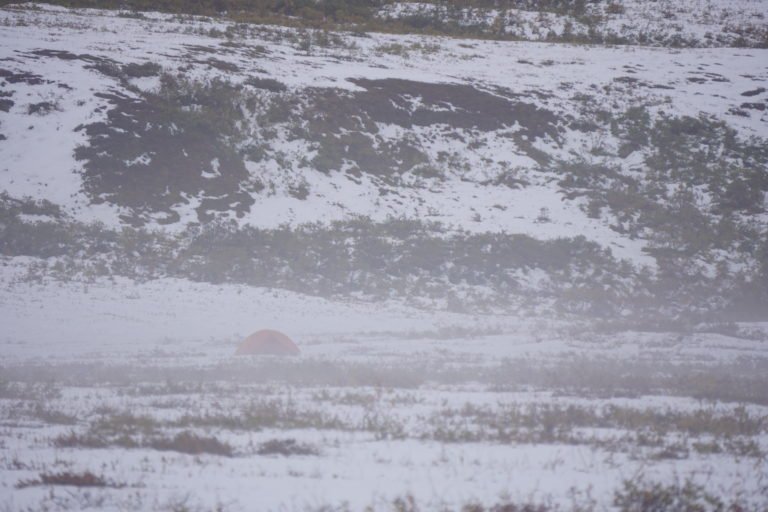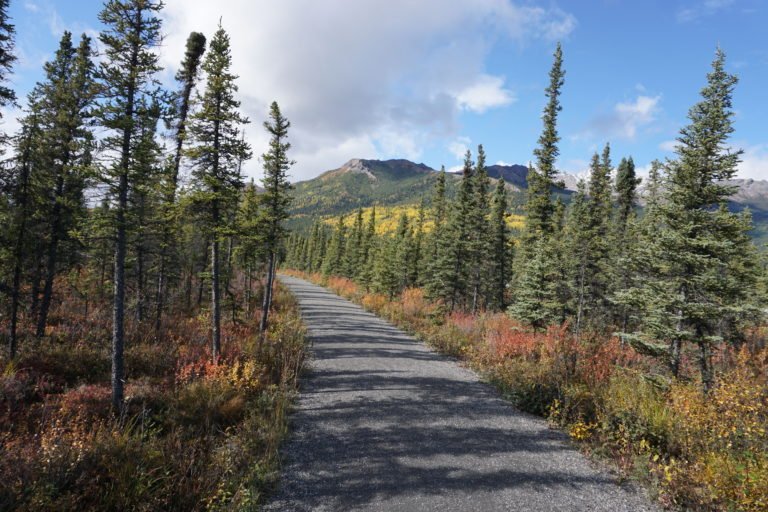Those seeking it can travel to any corner of Alaska to find silence, solitude, and perspective, but perhaps no single parcel of land in the world evokes the same grandiose romantic images of wilderness as Denali National Park. I was drawn to Alaska because of such places and knew that, if I could swing it, the long trip up to Denali would help scratch the ever-present itch to disappear into the wild.
I had spent the summer of 2015 in Kenai Fjords National Park and, with our season coming to a close, felt a strong desire to explore the state’s famed interior. Four months paddling the waters of Coastal Alaska, visiting glaciers, splashing with whales, and sharing blueberry bushes with black bears had provided a great taste of the Northern Wild, yet I wanted a full helping. As September struck the fjords my then girlfriend and I packed our bags and grabbed a water taxi back to the nearest coastal town of Seward, AK to start the journey north. Denali offers visitors a few short weeks of autumn before winter blankets the landscape in white. Not entirely sure what to expect, Casey and I were still eager to play whatever hand was dealt.
Early on September 2nd, we rolled out of the camper bed of our friend’s truck in the Seward Boat Harbor to catch a bus to interior Alaska. Beluga whales sent us on our way as we rounded Turnagain Arm, and each mile marker heading north served as a seasonal timestamp. The greens of summer gradually emblazoned into the bright oranges and reds of autumn, and before long rare glimpses of the park’s 20,310’ namesake peak appeared through the bus windows. As we approached Talkeetna, “The High One” was out in full force, unmistakable against the transitioning tundra and adjacent peaks of the Alaska Range. Peaks glistened in alpenglow and the electric fall colors faded to black as our 16-wheeled chariot rumbled down the last few miles of road toward the park. We strolled past the Denali National Park entrance sign and into the Riley Creek Campground for the night, lying down under a blanket of stars as a cool autumn air breezed through our canvas walls.
Casey and I had spent weeks gleaning knowledge from friends and had a rough idea of which of the many backcountry sections we wanted to explore. Much of the permitting, however, is left to chance as the system is built upon preserving both the wilderness and the backpacker experience. This mission has subdivided the park’s 6 million acres into 87 units – each of which has a designated number of overnight visitors. In conjunction with the size of the park, the system essentially guarantees that visitors will not encounter another party during their time in the wilderness.
Between anticipation and a chillier morning than expected, Casey and I were up and cooking breakfast by 7am and watching the compulsory backcountry safety video an hour later. As the video drew to a close, we assumed our spots in the Backcountry Permit Office cattle call. The ten of us in line poured over the unit description binder and examined vacancies for the next few nights. All of the sections recommended to us were full, so we took a shot at a random zone that still promised to be something special. Our plan was solid. We were to get on a camper bus at 10:00am and ride it over 50 miles into the park to Stony Creek. We would then spend the day hiking up the glacially braided stream in preparation to through-hike Unit 33 the next day and camp near Mount Galen in Unit 34 the following night. If all went well, we would make a summit bid on Mount Galen on our last day and catch a bus back to the park entrance that evening.
We stole a spot on a 9:30am shuttle bus, thanks to a shaggy haired long-time park ranger named Jack. The 10am camper bus was full, but this perennial child at heart was determined to get us to Stony Creek by 1:00pm. Jack had nothing but good things to say about the area, or so we assumed. Phrases like “brushy land” and “Super Mario Brothers world” did little in the way of actually informing us but certainly fueled our curiosity and excitement. Jack ran to the service counter as the 9:30am shuttle pulled into the Wilderness Access Center and returned with two tickets.
“Adam, right?”
“Actually, it’s John.”
“Not today. Here are your two tickets…Adam.”
Jack proceeded to convince our driver Paul that we will be getting on this bus and we will be getting dropped off at Stony Creek. The back-and-forth that followed showcased the best of Jack’s personality and introduced us to another legend in Paul. Possessing the fast dry wit of Norm McDonald and George Carlin but looking more like John Candy than either, Paul would be our escort into the heart of Denali National Park.
Paul shut the bus door behind us, and we were on our way. A herd of caribou dining in the fiery autumn tundra welcomed us into the park, as a brown bear browsed the riparian corridor around the next bend. Snowcapped peaks grew taller with every passing mile and provided the perfect backdrop for the colorful valley floor. We rumbled past the iconic views of the Teklanika and Toklat Rivers, veered over the harrowing Polychrome Pass and soon witnessed fall turn to winter. The oranges, reds, and yellows were barely peaking through the interior’s first winter snowfall, and as we noted this transition the worn brakes of the classic green Denali school bus slowed us to a halt.
“Stony Creek. Out the bus to your right, and just keep walkin’.”
Paul had made no effort in hiding his opinion about folks who got on a bus to see the park but chose to not get out and explore it. Yet as the bus doors closed and the endless snowy ridgelines of Unit 33 loomed before us, it seemed as though we were sent off with a mischievous smile.
Like a salty prison warden dropping off inmates it was, “Unit 33, end of the line.”
Dust kicked up on the road, and in a flash we were finally alone with Paul’s words echoing behind us.
“Out the bus to your right and just keep walkin’,” – into the Stony Creek gravel bar and its labyrinth of braided streams.
We followed the snow-dusted creek to the north for just under a mile, keeping ridgelines to our east and west. As the canyon narrowed and forced Stony Creek into a fierce singular flow, we opted to take the high road. Casey and I hugged the western ridge and trudged through ankle deep powder.
The fresh blanket of white was dotted with ptarmigan and brown bear tracks, and up and down we climbed on the undulating ridge – being sure to keep Stony Creek below us to our right.
A vast U-shaped valley lay ahead of us to the north and continued on as far as the eye could see. Below us stood a small grove of cottonwoods in the outwash of Stony Creek and the perfect place to hunker down from increasing winds. We descended the 1,000 feet back to the valley floor and pitched our tent in the trees. After changing into dry clothes and cooking dinner under bear protocol, we were soon fed, warm, and nestled in our sleeping bags. Most importantly, we had made it into the heart of the beast.
The next morning brought cool air and light drizzle, and Casey and I got an early start to break down camp while it was still semi-dry. We put wet socks in wet boots and continued up Stony Creek with the aim of turning southwest down Moose Creek and into Unit 34. Not thirty minutes into that morning’s hike we were rerouted as Casey pointed out a large brown spot 25 yards ahead of us in the leafless, shoulder-high shrubs.
“Hey Bear!”
We raised our arms above our heads and continued talking to a predator that could eliminate us in a flash if the mood struck. I kept my hand on the holstered bear spray, and we vacated the creek bed up to a 25-foot tall bench a safe distance from the bear. We watched through binoculars as this bear stayed busy harvesting low bush blueberries in preparation for a long winter ahead.
“Close call, eh?”
Our hearts were both racing as we pulled the topographic map out to identify a new route through our designated units.
We scanned the map and found a route through the Moose Creek drainage that would put us in Unit 34 before nightfall. Most importantly, we would be able to give the bear a wide berth. All that separated us from our new destination was one major river crossing that would allow us to gain another ridge leading to an easy stroll to the base of Mount Galen.
The crossing proved more difficult than anticipated and required us to wade calf high through freezing water. Once on the other side we made quick time up the ridge and resumed hiking through the spongey moss and tundra. After one particularly steep rise, the tundra became fully shrouded in snow. We had left fall behind and just entered winter. Knee deep in snow with miles ahead and nothing but hiking boots on our feet, we were in a bind. Push on through heavy rain and knee-deep snow toward likely blizzard conditions ahead or drop into the Little Stony Creek drainage and camp somewhere similar to where we had the night prior? We humbly opted for the latter.
Soon we were back on top of our bear viewing ridgeline glassing for our friend from earlier in the day. It was still there, munching on berries a safe distance away. The bear was blocking our desired route down Stony Creek, and Little Stony Creek cliffed out not too far ahead. Our last viable option was to tackle a number of low rolling summits to Stony Hill and the road. The bear grazing far below us, we hugged the ridgeline and were on our way.
Slowed by heavy snow, we eventually made it to the first rise that would mark the start of the ridge we sought to follow for the rest of the afternoon. Perched 300 feet above Stony Creek and the previous night’s canyon campsite, we stopped to watch our bear down in the outwash plain.
We were comfortable, sitting 300 vertical feet above it and a good quarter mile away with a fast moving river between us. People travel the world in hopes of getting the slightest glimpse of a brown bear, so we took our time enjoying every moment before pushing another 500 feet forward and 200 feet upwards to the next highpoint on our ridge. Both joking that after the previous months we were much better suited to be paddling kayaks than backpacking, I reached the top of the knoll just in time to see the grizzly emerge on the ridge behind Casey, less than two football fields away.
Casey joined me up top, and we marveled at the distance this bear had just covered. In the same amount of time it had taken us to meander a mere 250 vertical feet, the bear closed a quarter mile gap, crossed the raging Stony Creek, climbed a 300 foot scree embankment and was now aggressively sniffing the exact spot we had been admiring it from minutes before. Something definitely felt amiss, and we both instinctively raised hands overhead and started to holler. Unfortunately, this action served as more of a beacon than deterrent. Once it matched audio clues with our motion, the bear’s nose shot up from the tundra and it rapidly started moving in our direction – and fast.
“Shit. It’s coming this way.”
“Maybe not. We might have just spooked it into that other drainage.”
With our hands tied, we sat and watched as it moved faster and faster toward us – closing the gap as we prayed it would hit the brush and disappear in another direction. Sure enough we lost sight of it, and it of us, so we took a few steps back off the ridge and switched into high gear. Adrenalin kicked in and with a short window of invisibility from the bear, we hauled up the next peak to gain as much separation as possible. The past few minutes as the griz lifted its head, acknowledged our presence, and started to bound in our direction proved to be the most harrowing either of us had experienced in the backcountry, but it wasn’t over yet.
We caught our breath from higher ground and nervously chuckled at how ridiculous our situation had become. Our heart rates collectively slowed, and the surge of adrenalin began to dissipate – certain the bear was gone for good. Before completely turning our backs on the bear’s exit drainage, though, we opted to wait a few extra moments to confirm our theory.
To our surprise, the stalker came ambling over the rise that we had just vacated. In a horrific turn of déjà vu, the bear once again put his nose to the ground on the very spot we had alerted him from minutes prior. He sniffed, scoped the scene, and sniffed some more – a massive predator with a now very apparent motive. Relying on training rather than instinct, we did everything you wouldn’t do had this been a human follower. We gave up position.
“Hey bear!”
The bear that was once a safe quarter mile away, then a few hundred yards, and now maybe three hundred feet took our actions as a dead giveaway to our whereabouts, again, and immediately began to approach at a terrifying pace.
“Shit. This is not good.”
It was on a b-line in our direction, with one small descent into a gully separating it from where we were left exposed on top of the ridge. As he disappeared downward, there were just a few seconds to drop off of our highpoint, move quick on non-snowy terrain to the base of the next peak, and maybe even top out before the bear was once again in line-of-sight. Adrenaline pumping like gasoline, Casey and I huffed and puffed to the top, with eyes over our shoulders for the griz to crest the ridgeline. If he made it up before us, we would need to stand our ground. An aggressive bear watching us flee would further cement our hopelessness as unwelcome visitors in its tundra home. Our bear sprays were unholstered, but the last thing we wanted was a standoff.
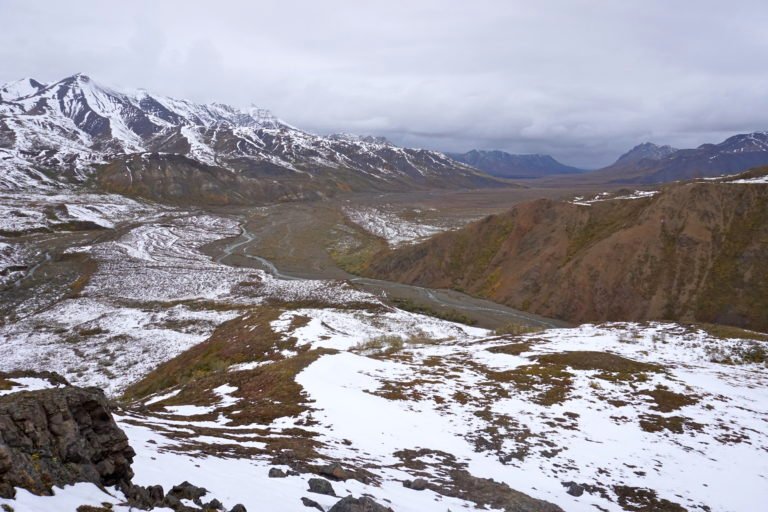
We first noticed the bear grazing near the widest part of Stony Creek below. This was taken from the top of our second viewpoint.
Out of breath and out of sight, we gained the nearest peak and a good deal of separation. We were looking south, just out of view of the road, and standing on what would now be our redirected high point for the day. We looked at each other with a new goal in mind – reach the road in time to catch the last westbound bus before all park traffic stopped for the night.
With a bear on our tail and a bus to catch, we needed to move quickly. Our best option took the shape of a 1,000-foot glissade down a scree field into Stony Creek, where we could follow the braids out to the road. Our glissade delivered us to the valley floor in a matter of minutes, and soon we were wading through Stony Creek and struggling through its thick vegetation.
The griz was left with its nose on the ground about a half mile away. Meanwhile, we splashed and bushwhacked for another twenty minutes before emerging back on the road with just enough time to take off packs and grab a drink of water before taking in the welcome sight of Paul’s big green school bus kicking up dirt to the east.
The bus dropped us at the Eielson Visitor Center to regroup before continuing into Unit 34, having foregone the idea of hiking through Unit 33. A short bus ride west from the visitor center left us at a favorable notch between two steep ridges to gain access into our next unit. We stepped off the bus in heavy fog and checked our pride at the door, humbly working our way through wet tundra and thick brush. As we struggled up the slippery embankment, the route we had earlier abandoned along Moose Creek was barely visible. Our premonitions were confirmed – the snow here was undoubtedly deeper than in Unit 33.
Light was already fading thanks to a snow storm building over the Alaska Range, and Casey and I needed to get a warm and dry camp established fast. Working in overdrive, we shoveled out a tent pad, pitched our bright orange tent, and walked well over 100 yards away to our hasty kitchen. We didn’t want to risk another chance encounter, and my heart sank as my dinner plate slipped through my cold, wet, and trembling hands. This couldn’t be happening. A spicy ramen scent was now coating a berry-covered ground near camp. This can’t be happening. We both ate quickly and did our best to pick up every last sign of my mistake.
After stashing our food and bear can far away from camp, we traced our footprints back to the tent – the bright orange canvas now shrouded in the storm and fog. Donning all of our dry layers, we laid down in anticipation of a 7am bus back to the park entrance the following morning. Restless sleep was interrupted by heavy rain and winds, as I counted down the hours until the sun would rise.
Morning came early, and we both welcomed it with the utmost gratitude. Before long, we were loading into another bus and heading east out of the park – warm and dry.
In contrast to our ride into the park two days ago, we watched winter transform back to fall through the steamy bus windows. The cold and foggy weather at elevation turned warm and sunny as we rumbled east. The undulating white landscape gave way to the electric reds, oranges, and yellows of a tundra ablaze. Soon, we were back at the Riley Creek Campground with stories to tell. However we also only had one more day in the Alaskan interior, and sitting idle simply wasn’t an option.
Brown bears, rain, snow, and cold be damned. In the wilderness you play the cards that you’re dealt. No matter how each game turns out those of us that cannot live without wild places will always ante up, again and again. Here we found ourselves, sitting at one of the premiere high stakes tables in the wilderness world. This was Alaska. This was Denali. This was wilderness. Why not get out and play one last hand?
